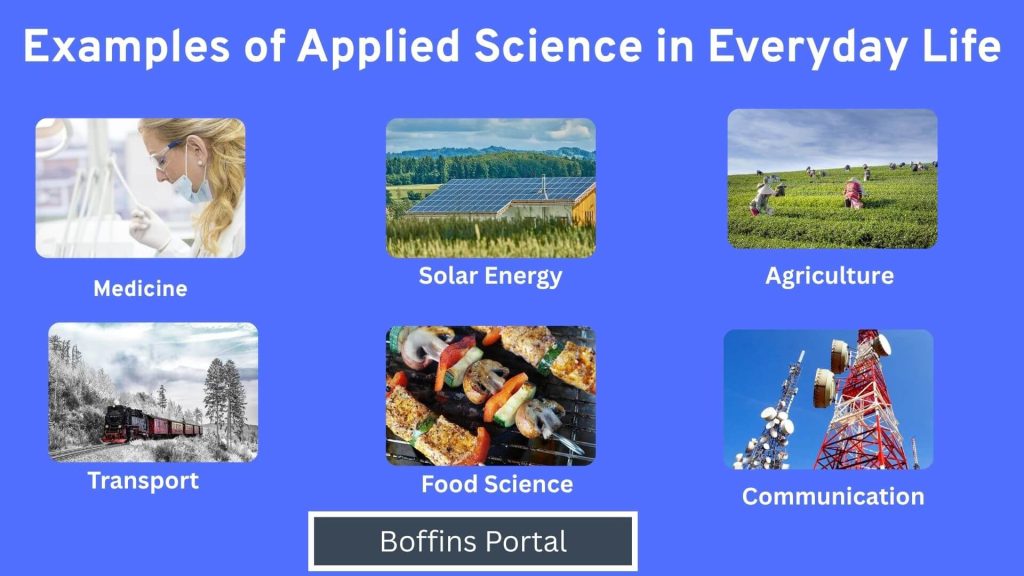Science shapes our daily lives, from the detergents, food, and clothes we use to the medicines and machines we rely on. Basic science explains natural processes—how our bodies work, how plants grow, and how substances react—while applied science uses this knowledge to solve real-world problems. Pharmacists use biology and chemistry to create medicines, engineers apply physics to build machines, and pilots draw on astronomy for navigation. Every new invention, from advanced drugs to telehealth technology, grows out of applied science.

Examples of Applied Science in Everyday Life
1. Medicine
Scientific knowledge is applied significantly in medicine. In microbiology, for instance, knowledge of microscopic organisms is applied. Biomedical technology requires knowledge of physics.
Epidemiology is the study of the causes and effects of diseases in a population. Knowledge of mathematics and pathology is applied in epidemiology.
The manufacture of drugs used in medicine requires knowledge in chemistry and biology. A doctor operating a patient applies the knowledge acquired in biology.
2. Solar Energy
Converting solar energy to electrical energy requires the application of physics concepts. Solar energy is a better source of energy. It requires minimal input and conserves the environment.
Tapping solar energy and converting it to other forms of energy causes no pollution in our environment.
Solar energy is converted to electrical energy using photovoltaic panels. The photo-voltaic panels are found in a system called the PVT system.
The system requires knowledge in energy and heat transfer. Physics concepts are applied in this system.
3. Agricultural Science
Scientific knowledge and technological inventions in food production are applied in agronomy.
Modern farm machines, chemicals used in agriculture, and genetically modified plants are made from applied science.
Breeding and raising animals with desired characteristics requires knowledge of agriculture and zoology.
The invention of farm machines requires knowledge of physics.
4. Food science
Food science focuses on all aspects of food. Engineering provides machinery for field operations, chemical engineering provides chemicals used in food production and preservation, and biological sciences offer knowledge on food preservation
5. Transport
Locomotives used in road, air, and water transport require scientific techniques to construct and operate.
Applied engineering contributes to new inventions made in vehicles and aircraft to improve transportation.
Zero-emission cars, electric trains, and modern cruises are made to reduce pollution.
The construction of airplanes that withstand lightning has improved safety in airplanes.
6. Communication
Communication is easier with the invention of telephones and cell phones.
Skills acquired in physical sciences and electronics have helped develop innovations in communication.
Computer skills have helped in the storage of data for mobile device users. Cloud computing is an application of skills we learn in computer science.
7. Manufacture of useful chemicals
We use chemicals like detergents, body oils and lotions, fertilizers, and processed food. Chemistry concepts are applied in the manufacture of these chemicals.
Bleaching agents used in the paper and sugar industry like calcium hypochlorite are manufactured by applying chemistry concepts.
8. Extraction of metals from their ores
Reactive metals such as sodium and aluminum are extracted from their ores by electrolysis.
The solid ores are converted to molten form by heating. When an electric current is passed through the molten ores, the metals are discharged at the cathode.
Less reactive metals like zinc and copper are extracted by reducing their ores using coke and carbon monoxide. Electrochemistry and reduction reaction concepts are applied in the above processes of extraction.
Purification of metals such as copper and zinc is done by electrolysis of the impure metal.
9. Electrical energy from fuel cells
A fuel cell converts chemical energy in hydrogen and oxygen to electrical energy.
The gases are converted to water using potassium hydroxide electrolyte. Hydrogen and oxygen combine to form water. Electrical energy is released from the reaction.
At the negative terminal:
H2(g) + OH(aq)→H2O(l)+ 4e
At the positive terminal:
O(g)+H2O(l) + 4e → 4OH_
Overall equation:
2H2(g) +O2(g) → 2H2O(l)
Electrochemistry concept is applied in this process.
10. Softening of hard water
Hard water contains magnesium ions and calcium ions. The presence of these ions in water causes stains on white garments and wastes soap.
Water hardness is removed when these ions are removed from the water. There are many ways of removing water hardness, including boiling and adding chemicals like sodium carbonate and ammonia.
Knowledge of identifying ions and displacement reactions in chemistry is applied in softening hard water.
.
